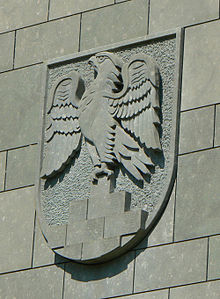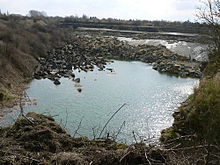Anröchter stone
There are two different colored natural stones from the Anröchter stone , which is often incorrectly referred to as the Anröchter dolomite . There is a green type, even green sandstone , greenstone called, and a bluish type Anröchter Blue . It is a limestone deposit that is extracted in the Soester Börde . These natural stones come from the Turonium , a level of the Upper Cretaceous .
Naming and occurrence
The horizons of the Upper Cretaceous in question, which are in the south of the Westphalian Chalk Bay between the Haarstrang and Lippe, have very different mineral contents. From a technical point of view, only those rocks are important that were previously mined near Soest , Werl , Anröchte and Rüthen . The name Grünsandstein comes from the local miners. The miners use this term for all sands occurring there, provided they are solidified and colored green. The content of sand grains in the Anröchter Stein and the others is so low that it is better to speak of sandy limestones. The deposit is 20 to 25 meters thick around Soest and only 3 to 4 meters thick around Rüthen. The occurrence at Anröchte and Klieve is east of Soest in the southeast of the Münsterland. There are seven quarries in operation. The rock deposits around Rüthen do not belong to the Turon, but to the lowest Cenoman (Essen green stone) and are now mined in a quarry. The Anröchter stone benches reach a thickness of 2 meters. The rock is extracted from two bank layers, with the upper bank colored blue and the lower bank green. The green bank is particularly popular.
The term green sandstone, which is used for the technically used rock deposit, is not correct in terms of geology, because it is a limestone with only a small percentage of quartz grains and therefore not a sandstone . The rock broken today (2008) is now referred to as the Anröchter stone . This was a reaction to the names and colors, which led to irritation, because on the one hand there is a blue and green variety and on the other hand, the Anröchter stone was incorrectly referred to as Anröchter dolomite for a long time. This was due to the fact that this natural stone shows dolomitic textures. Other names given by geology are: glauconitic sand limestone and glauconitic sandstone .
mineralogy
Due to the high carbonate content of around 64 percent (carbonate clasts 33 percent and glauconite 21 percent) and a quartz content of around 31 percent, it is limestone . The remaining 5 percent are rock debris and mica . Glauconite is a weathering mineral, it colors this natural stone green or bluish. The rock is of sedimentary origin and formed on the seabed of the Upper Chalk Sea in only shallow water under warm climatic conditions. Fossil evidence of the prevailing environmental conditions at that time are mussels, snails, sea urchins, sponges and plants. Gray and dark gray peel remains up to 3 cm have been preserved.
Green stone is a relatively soft stone that is heavily attacked by the weather and industrial emissions. This is due to its high proportion of lime. In the weathering processes, the calcareous binding agent and the glauconite decompose. This natural stone in the base area is particularly at risk of weathering if de-icing salt is scattered there in winter.
use
Examples of the historical use of the Anröchter stone are the church of St. Maria zur Wiese , a Gothic hall church in Soest , churches in Anröchte and Erwitte (12th century) and churches in Lippstadt (Stifts, Marien, Nikolai and Jacob churches). There is a green sandstone museum in the Dombauhütte set up at the Soest Wiesenkirche, where restoration work is being carried out with this natural stone. In northern Germany, the Anröchter stone has been used and proven in large quantities as a building and monument stone since ancient times. It is used in exterior and interior design: for facade cladding, floor coverings, stairs, window sills, fireplace cladding and rustic masonry as well as for stone carving. When used correctly and correctly and professionally laid, the Anröchter stone is suitable for outdoor use and frost-resistant, but not against road salt, as otherwise the material tends to peel off. Various sculptures from Anröchter stone have been created by the stone sculptor Ulrich Rückriem .
- Usage examples for Anröchter Stein
Marienkirche in Lippstadt
St. Petri in Soest
Modern sculpture:
OT, Ulrich Rückriem , EssenFront view of the courtyard in Soest
Emanuela Camacci - Towards , 2013 in Hofheim am Taunus
See also
literature
- W. Dienemann and O. Burre: The usable rocks in Germany and their deposits with the exception of coal, ores and salts. Enke-Verlag, Stuttgart 1929, p. 296ff
- Wolf-Dieter Grimm: picture atlas of important monument rocks of the Federal Republic of Germany. Edited by the Bavarian State Office for Monument Preservation. Lipp-Verlag, Munich 1990, ISBN 3-87490-535-7 .
- Karlfried Fuchs: Natural stones from all over the world. DWCallwey Publishing House. P. 185.
- Friedrich Müller : INSK compact The international natural stone index for the current market. Ebner publishing house. Card index 96.1.
Web links
- Sculpture by Ulrich Rückriem from Anröchter Stein in Münster
- Anröchter Stein and his company
- Bauhütte of the Wiesenkirche Soest
- Gravestones made from Anröchter stone
- Surface of the Anröchter green sandstone













